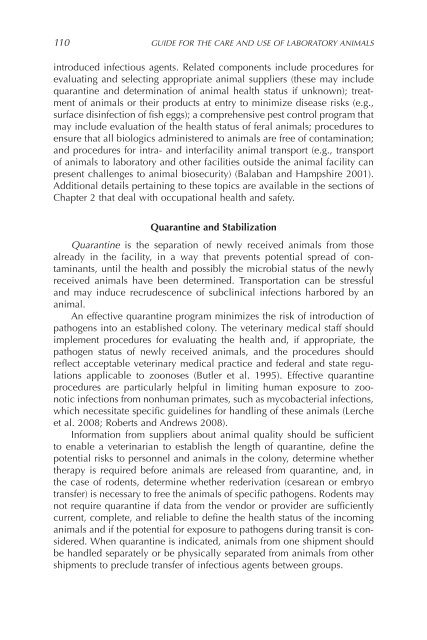Guide for the Care and Use of Laboratory Animals - Office of ...
Guide for the Care and Use of Laboratory Animals - Office of ...
Guide for the Care and Use of Laboratory Animals - Office of ...
- No tags were found...
Create successful ePaper yourself
Turn your PDF publications into a flip-book with our unique Google optimized e-Paper software.
110 GUIdE FOR ThE CARE ANd USE OF LAbORATORy ANIMALSintroduced infectious agents. Related components include procedures <strong>for</strong>evaluating <strong>and</strong> selecting appropriate animal suppliers (<strong>the</strong>se may includequarantine <strong>and</strong> determination <strong>of</strong> animal health status if unknown); treatment<strong>of</strong> animals or <strong>the</strong>ir products at entry to minimize disease risks (e.g.,surface disinfection <strong>of</strong> fish eggs); a comprehensive pest control program thatmay include evaluation <strong>of</strong> <strong>the</strong> health status <strong>of</strong> feral animals; procedures toensure that all biologics administered to animals are free <strong>of</strong> contamination;<strong>and</strong> procedures <strong>for</strong> intra- <strong>and</strong> interfacility animal transport (e.g., transport<strong>of</strong> animals to laboratory <strong>and</strong> o<strong>the</strong>r facilities outside <strong>the</strong> animal facility canpresent challenges to animal biosecurity) (Balaban <strong>and</strong> Hampshire 2001).Additional details pertaining to <strong>the</strong>se topics are available in <strong>the</strong> sections <strong>of</strong>Chapter 2 that deal with occupational health <strong>and</strong> safety.Quarantine <strong>and</strong> StabilizationQuarantine is <strong>the</strong> separation <strong>of</strong> newly received animals from thosealready in <strong>the</strong> facility, in a way that prevents potential spread <strong>of</strong> contaminants,until <strong>the</strong> health <strong>and</strong> possibly <strong>the</strong> microbial status <strong>of</strong> <strong>the</strong> newlyreceived animals have been determined. Transportation can be stressful<strong>and</strong> may induce recrudescence <strong>of</strong> subclinical infections harbored by ananimal.An effective quarantine program minimizes <strong>the</strong> risk <strong>of</strong> introduction <strong>of</strong>pathogens into an established colony. The veterinary medical staff shouldimplement procedures <strong>for</strong> evaluating <strong>the</strong> health <strong>and</strong>, if appropriate, <strong>the</strong>pathogen status <strong>of</strong> newly received animals, <strong>and</strong> <strong>the</strong> procedures shouldreflect acceptable veterinary medical practice <strong>and</strong> federal <strong>and</strong> state regulationsapplicable to zoonoses (Butler et al. 1995). Effective quarantineprocedures are particularly helpful in limiting human exposure to zoonoticinfections from nonhuman primates, such as mycobacterial infections,which necessitate specific guidelines <strong>for</strong> h<strong>and</strong>ling <strong>of</strong> <strong>the</strong>se animals (Lercheet al. 2008; Roberts <strong>and</strong> Andrews 2008).In<strong>for</strong>mation from suppliers about animal quality should be sufficientto enable a veterinarian to establish <strong>the</strong> length <strong>of</strong> quarantine, define <strong>the</strong>potential risks to personnel <strong>and</strong> animals in <strong>the</strong> colony, determine whe<strong>the</strong>r<strong>the</strong>rapy is required be<strong>for</strong>e animals are released from quarantine, <strong>and</strong>, in<strong>the</strong> case <strong>of</strong> rodents, determine whe<strong>the</strong>r rederivation (cesarean or embryotransfer) is necessary to free <strong>the</strong> animals <strong>of</strong> specific pathogens. Rodents maynot require quarantine if data from <strong>the</strong> vendor or provider are sufficientlycurrent, complete, <strong>and</strong> reliable to define <strong>the</strong> health status <strong>of</strong> <strong>the</strong> incominganimals <strong>and</strong> if <strong>the</strong> potential <strong>for</strong> exposure to pathogens during transit is considered.When quarantine is indicated, animals from one shipment shouldbe h<strong>and</strong>led separately or be physically separated from animals from o<strong>the</strong>rshipments to preclude transfer <strong>of</strong> infectious agents between groups.
















